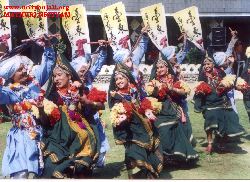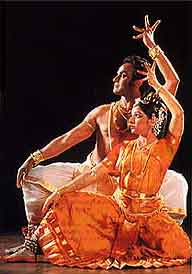|

Dances As the home of rich folk tradition,
Andhra Pradesh offers a variety of performing arts unique to its
culture. Kuchipudi, the famous classical dance takes its name
from a village 60 kilometers away from Vijayawada just above the delta
region of the river Krishna. It was Siddhendra Yogi who developed this
form incorporating a repertoire of religious themes. This dance-drama
enactment throbs with Telugu lyrics, Sanskrit verses and is
distinguished from other dance forms which are interspersed by
narratives making it popular and expressive. Mathuri  This
folk dance is generally performed by the backward classes of the UMJI
and INDRAVELI forest areas of UTNOOR TALUK of ADILABAD DISTRICT of
ANDRHA PRADESH. They dance for hours together on the occasion of Krishna
Astami in Sravana Maasam. This dance is performed by women and men
separately and together. There are many occasions wherein men and women
dance together. Because of their unique hair style they are also called
KOPPU LAMBADI. Women dance is very slow in tempo whereas male dance is
fast and very vigorous. Male artists hold a handkerchief and a stick in
their hands. The instruments which are used in this dance are called as
Sutta, Tasha or Nagara, Dappu etc. This
folk dance is generally performed by the backward classes of the UMJI
and INDRAVELI forest areas of UTNOOR TALUK of ADILABAD DISTRICT of
ANDRHA PRADESH. They dance for hours together on the occasion of Krishna
Astami in Sravana Maasam. This dance is performed by women and men
separately and together. There are many occasions wherein men and women
dance together. Because of their unique hair style they are also called
KOPPU LAMBADI. Women dance is very slow in tempo whereas male dance is
fast and very vigorous. Male artists hold a handkerchief and a stick in
their hands. The instruments which are used in this dance are called as
Sutta, Tasha or Nagara, Dappu etc.
Koyadance The Koya tribes of Andra Pradesh's
forests have strong affinity with Marias, tribes wearing bison-horn head
dress in Bastar, of Orissa state. Their dances have the same forest
tribal rites, ritual, magical significance and an identical energy. The
Koyas live in remote forest hill-tops in Visakapatnam District.
Their dances include Mayura Nat (Peacock
dance) exclusively performed by men, Harvesting Festival dances
performed in the month of April every year.
The dance is done in small steps, forming
complex patterns on intricate rhythmical phrases of half-beats and
quarter beats. The musical and rhythmic accompaniments mainly consist of
the Pioodi and Mayunga. Pioodi is a flute of three feet bamboo stick
with five holes on the end. Kuchipudi  "Classical
Dance "Kuchipudi" from Andhra Pradesh" Kuchipudi a dance
form given to the Indian dance platform by a small village in the Andhra
Pradesh. Kuchipudi is not mere a dance form but is combination of dance,
gestures, speech and song. A Kuchipudi dancer has to to be well versed
in dancing, acting, music, various languages and texts. Kuchipudi was
born in a small village of Andhra Pradesh. There it developed as a
tradition by the same name where it was born. Kuchipudi although now
recognized as an independent dance form is related to Bharat Natyam. It
was in the 17th century during the bhakti movement in the South India
that Siddendra Yogi the formulator of the dance form selected some boys
from the village to perform dance drama. Thus came the Kuchipudi in this
world. In those days Kuchipudi was performed once in a year and the
dance form was cautiously kept out of the reach of Devadasis. From the
fist performers the technique and skills of this form got handed over
the generations to acquire the present form. Some of the legendary
performers and gurus were Kuchipudi Brahmins like Lakshmi Narayan
Shastri and Chinta Krishna Murti who excelled in roles like Satyabhama
in Bhamakalapam; later gurus include Vedantam Chinna Satyam. Today both
group performances and solo performances are popular but experimentation
are always being done with the choreography. Kuchipudi is a dance a
combination of movements of the whole body. "Classical
Dance "Kuchipudi" from Andhra Pradesh" Kuchipudi a dance
form given to the Indian dance platform by a small village in the Andhra
Pradesh. Kuchipudi is not mere a dance form but is combination of dance,
gestures, speech and song. A Kuchipudi dancer has to to be well versed
in dancing, acting, music, various languages and texts. Kuchipudi was
born in a small village of Andhra Pradesh. There it developed as a
tradition by the same name where it was born. Kuchipudi although now
recognized as an independent dance form is related to Bharat Natyam. It
was in the 17th century during the bhakti movement in the South India
that Siddendra Yogi the formulator of the dance form selected some boys
from the village to perform dance drama. Thus came the Kuchipudi in this
world. In those days Kuchipudi was performed once in a year and the
dance form was cautiously kept out of the reach of Devadasis. From the
fist performers the technique and skills of this form got handed over
the generations to acquire the present form. Some of the legendary
performers and gurus were Kuchipudi Brahmins like Lakshmi Narayan
Shastri and Chinta Krishna Murti who excelled in roles like Satyabhama
in Bhamakalapam; later gurus include Vedantam Chinna Satyam. Today both
group performances and solo performances are popular but experimentation
are always being done with the choreography. Kuchipudi is a dance a
combination of movements of the whole body.
Lambadi
Associated with
daily tasks like harvesting, planting, sowing, etc., the Lambadi is
performed by the Banjaras, a semi-nomadic tribe seen all over Andhra
Pradesh. Costumes embroidered with glass beads and mirrors, ornate
jewellery, ivory bangles, brass anklets and a natural rhythm makes this
dance a colourful exposition of joy which is the highlight of many an
occasion. Bonalu
The folk festival of Bonalu in
the Telangana region brings with it a celebration of colourfully dressed
female dancers balancing pots (Bonalu), stepping to the rhythmic beats
and tunes in praise of the village deity Mahankali. Male dancers called Potharajus
follow the female dancers to the temple lashing whips and emerald
margosa leaves tied around their waists adding colour to the roaring
trumpets and pulsating percussion. Dhimsa
Generally performed in the local
fairs and festivals in Visakhapatnam district, this tribal dance form
sees 15-20 women forming a chain and dancing in praise of the local
deity. Women attired in typical tribal dresses and ornaments dance to
the beats. Instruments like Mori, Thuduma and
Dappu are played by the members. Veeranatyam
Sati Devi, Shiva's first wife was outraged and humiliated and Lord Shiva
was angered at this. The dance that he performed at this outrage is
called Veeranatyam. He picked a lock out of his Jata-Jhuta (hair) and
created Veerabadhra. The Veeramusti community who claim to be the
descendants of Veerabadhra, perform this vigorous dance with instruments
like Thambura, Soolam, Dolu, Thasha and Veernam
usually at Draksharamam in East Godavari district of Andhra Pradesh.
This place is believed to be the birth place of Veerabhadra, known as
Dakshawatika. Butta Bommalu
Also known as the dance of masks is a typical folk dance form,
popular in Tanuku of West Godavari district of Andhra Pradesh. Butta
Bommalu which literally means basket toys,are made of wood husk,
dry grass and cow dung. Each dancer wears a different mask over the head
and shoulders enlarging the scope of the performer and dances to a
nonverbal rhythm which adds colour to the movements. Dappu
The Dappu, a percussion instrument made of
goat skin and wood, is a tambourine-like drum which when played with
sticks creates a rhythm that’s softened only by the sound of ankle
bells that the 16-20 dancers wear. Part of a Telangana custom which sees
the Dappu dancers at the front of any procession, whether it be for
Jataras, festivals or marriages, this is truly a celebration of dance in
all its vibrancy. Chindu Bhagawatham
This lively art form hails from
Nizamabad district. The performers in colourful make up and costumes
dance to the musical patterns set by cymbals,
tabla and harmonium. Mythological themes are usually enacted and
the audience is mostly rural. The applause and appreciation is however
universal. Tappeta Gullu
Popular in Srikakulam and
Vijayanagaram districts, this is a devotional dance which invokes the
Rain God with its vigour, rhythm and tempo. Also performed during
festivals, the dance sees 15 – 20 artists with drums slung around
their necks creating a mesmerising beat and performing heart stopping
acrobatics. Top
|



